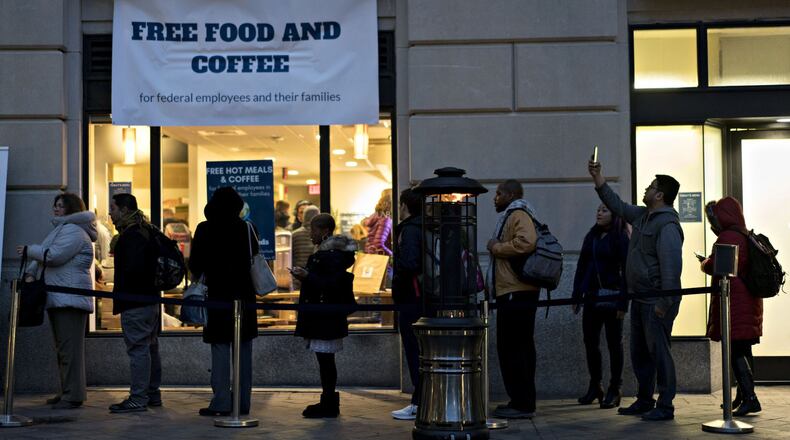If the recent government shutdown didn’t teach us anything else, it should be that all of us had better be saving for a rainy day.
Just weeks into the partial shutdown, we were bombarded with stories about people turning to food banks to feed their families. We heard stories about people who were in dire straits because they couldn’t afford to buy medicine or pay for child care or buy fuel to get to work or make their mortgages. People were struggling to cope.
It didn’t take long for us to realize the vast majority of federal workers — indeed millions of Americans — are financially vulnerable. And that’s putting things mildly.
The hard truth is we do not save, said Giacomo Santangelo, a professor of economics at Fordham University.
According to the Federal Reserve, Americans’ personal savings rate is less than 7 percent, that is for every $1 we take home, we save, on average, less than 7 cents. It was 13 percent in the 1970s.
“This trend has put consumers in a risky and unsustainable position,” Santangelo said.
Citing the Federal Reserve’s “Report on the Economic Well-Being of U.S. Households in 2017,” he said that when faced with a hypothetical expense of only $400, 59 percent of adults in 2017 said they could easily cover it, using entirely cash, savings, or a credit card paid off at the next statement.
“This means that 41 percent of consumers would have to go into debt to cover small unexpected expenses such as a car repair or replacing a broken appliance, and it’s been this way for years,” Santangelo said. “The government shutdown only exacerbates the problem.”
Not only is stress put on government employees dependent upon income from their government jobs, he said, what little assistance that people in need may receive from some government programs stops.
RELATED | Government shutdown: Trump signs bill to temporarily reopen government
Some experts say as many as 80 percent of us are living paycheck to paycheck. Some believe that figure is a little high.
What’s not up for debate, according to Walda Katz-Fishman, a professor of sociology at Howard University, is the economic crisis has set in and its social fabric has weakened. That’s been true since at least the late 1960s.
“The real value of wages, for example, has been declining, and good jobs with benefits and security have been decreasing,” Katz-Fishman said.
She noted too that Social Security Administration data indicates that almost 50 percent of full-time American workers earn less than $30,000 a year — including 13 percent earning less than $5,000 and 8 percent earning $5,000 to $10,000. Another 21 percent earn between $30,000 and $50,000. Together 70 percent of Americans are living on less than $50,000. Clearly the working class (often called the “middle class”) is living at the edge.
This isn’t because people are living above their means. More often than not, their wages just aren’t keeping up with the cost of living.
I’ve been there.
Credit: The Atlanta Journal-Constitution
Credit: The Atlanta Journal-Constitution
In the winter of 1982, I was a cub reporter covering courts for the Delta Democrat-Times in Greenville, Mississippi, when my father died from cancer. I’d traveled home to attend his funeral when a horrible snowstorm hit, shutting the freeways down. I was unable to return to work.
My editors were well aware of this, but I did not get a paycheck when I returned. By then, both of my parents were dead. My three older siblings had their own problems. My grandmother was caring for my four younger siblings. I had no savings and no one to help me.
Decades before billionaire Commerce Secretary Wilbur Ross suggested struggling federal workers use credit or take out a loan to get through the partial shutdown, I took that route to cover my rent. The next year, I left the DD-T for a general assignment position at the Raleigh Times, but I never forgot that experience.
RELATED | Commerce Secretary says he doesn't understand why furloughed workers are turning to food banks
Katz-Fishman told me that two key forces — globalization and the ongoing technological revolution — are driving the economic and social crisis of workers and their families now.
“Globalization moved production around the world with corporations seeking the cheapest labor to maximize their profit. U.S. workers are now in competition with millions of workers globally driving down wages and benefits,” she said. “On the other hand, automation, robots, digitization and artificial intelligence drive workers out of production and wages down.”
Thus multiple jobs, part-time, contingent labor, and the gig economy are the reality for the majority of workers today.
Should another partial shutdown happen in the next week or so, there’s little to do to prepare in such a short period of time, except maybe begin to look for another job, Bentley University economics professor Dave Gulley said. “There are reports of many government employees and contractors who’ve begun doing just that.”
Gulley said that this suggests that as long as the overall economy continues to perform well and the labor market remains strong, that households will be able to maintain their current standards of living.
He said, however, “when the next recession hits, households without liquid assets to tide them over will be in trouble nearly immediately. Households as a whole are less leveraged than before the Great Recession and so may have some room to borrow to tide themselves over, but this is only a short-term fix.”
Katz-Fishman said that what is happening is so new, it’s hard to say what the future might hold. The economic and political polarization we are living through is really a process of social destruction of the world as we knew it.
“We need to organize ourselves, educate ourselves, and organize more — for the immediate needs of those laid off and the rest of the 80 percent living paycheck to paycheck,” she said.
And we need to save whatever we can for the rainy day ahead. With or without a government shutdown, it will come.
Find Gracie on Facebook (www.facebook.com/graciestaplesajc/) and Twitter (@GStaples_AJC) or email her at gstaples@ajc.com.
About the Author
Keep Reading
The Latest
Featured






